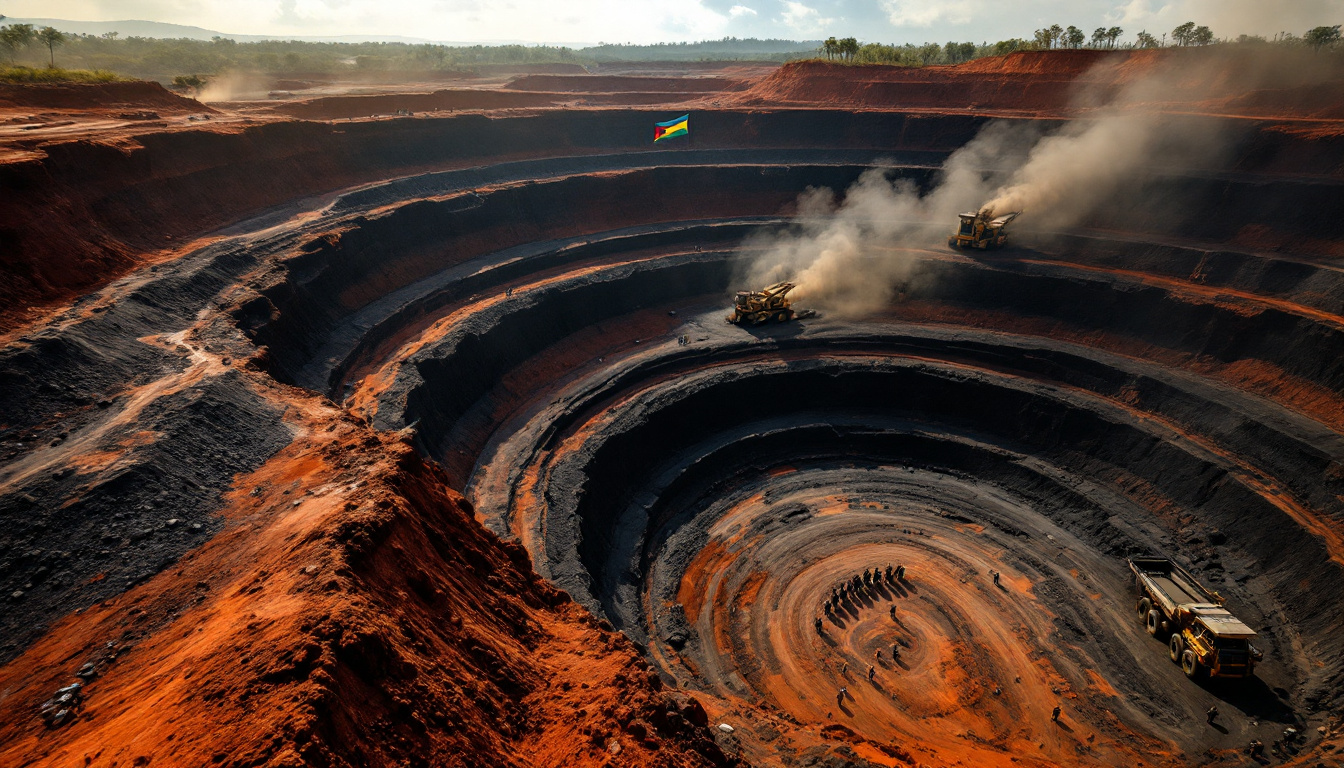What Was the Larapintine Sea?
The Larapintine Sea was an ancient inland ocean that covered much of central Australia over 500 million years ago. Unlike the more recent Eromanga Sea (which existed around 100 million years ago and created the Great Artesian Basin), the Larapintine Sea formed during the early Paleozoic era, spanning from the Cambrian into the Ordovician period. This vast marine environment transformed what is now Australia's arid outback into a thriving underwater ecosystem during a critical period in Earth's evolutionary history.
Origin and Formation
The Larapintine Sea emerged when Australia was still part of the ancient Gondwana supercontinent. This massive inland sea formed when the crust beneath central Australia sagged and rifted, creating what geologists call the Centralian Superbasin. The timing coincided with the waning of neo-Proterozoic ice ages, when global sea levels rose significantly.
This ancient sea wasn't a single basin but rather a complex network of interconnected depressions including the Amadeus, Georgina, Ngalia, and Canning basins. Tectonic activity created pathways for ocean waters to flood across the continent's interior, establishing a marine environment that would persist for millions of years.
Geographical Extent
At its maximum extent, the Larapintine Sea spanned vast areas across what is now the Northern Territory, Queensland, South Australia, and Western Australia. Unlike a completely landlocked sea, it maintained connections to open oceans at both ends—westward through the Canning Basin and eastward toward the Paleo-Pacific.
This extensive inland sea effectively bisected the Australian landmass, turning the central region into a thriving marine realm. The ore deposit geology of Australia was significantly influenced by these ancient seaways. The Larapintine Sea created a tropical seaway that stretched for thousands of kilometers across what today appears as one of Earth's driest landscapes.
When Did the Larapintine Sea Exist?
The Larapintine Sea existed during a crucial period in Earth's evolutionary history, coinciding with the explosion of early complex life forms. Its waters covered central Australia long before dinosaurs roamed the Earth, during a time when the first vertebrates were just beginning to evolve.
Temporal Timeline
The Larapintine Sea originated over 500 million years ago during the Cambrian period, when multicellular life was diversifying rapidly. It reached its greatest extent during the early to middle Ordovician period, creating vast shallow marine environments across the Australian interior.
Around 450 million years ago, during the late Ordovician, the sea began a gradual retreat as global climate changes reduced sea levels worldwide. The final disappearance of the Larapintine Sea came following significant tectonic upheaval during the mid-Paleozoic era, approximately 400-300 million years ago.
Geological Evidence
The existence of this ancient sea is confirmed by extensive geological evidence across central Australia. In the Amadeus Basin of the Northern Territory, scientists have documented up to 600 meters of shallow marine sandstone deposits, testifying to the long-term persistence of marine conditions.
The Georgina Basin contains thick layers of limestone and shale—classic indicators of marine environments. The relatively small Ngalia Basin, covering approximately 15,000 square kilometers, accumulated an astonishing 6 kilometers of sediment during this period, demonstrating the sea's long-term stability and biological productivity.
What Was the Environment of the Larapintine Sea Like?
The Larapintine Sea created a tropical marine environment in what is now Australia's arid interior. Understanding this ancient ecosystem provides a remarkable contrast to the modern landscape and reveals how dramatically Earth's environments can transform over geological time.
Physical Characteristics
Rather than a single uniform body of water, the Larapintine Sea consisted of a series of interconnected shallow bays and shelf seas. The environment was somewhat similar to today's Persian Gulf or the ancient Western Interior Seaway that once divided North America.
During this period, central Australia was positioned near the paleo-equator, resulting in warm waters that supported diverse marine ecosystems. The sea featured a range of environments, from shallow nearshore tidal flats to deeper subtidal zones, creating numerous ecological niches for marine life to exploit.
Climate Conditions
Fossil evidence indicates that the Larapintine Sea experienced tropical to subtropical conditions. The presence of species restricted to low latitudes confirms the warm-water nature of this ancient marine environment.
The seafloor hosted reef-like communities dominated by algae and sponges, rather than the coral reefs we associate with tropical waters today (corals had not yet evolved to become dominant reef-builders). This environment remained stable for tens of millions of years, nurturing biodiversity across Gondwana's interior and serving as an evolutionary laboratory for early marine life.
What Life Thrived in the Larapintine Sea?
The Larapintine Sea hosted a diverse ecosystem during a critical period in evolutionary history. These waters teemed with ancient life forms that have left a rich fossil record in the rocks of central Australia.
Marine Biodiversity
Bivalve mollusks dominated many fossil assemblages from the Larapintine Sea. These ancient relatives of modern clams and mussels thrived in the shallow, nutrient-rich waters. Alongside them lived ancient gastropods (snail relatives), trilobites (extinct arthropods with segmented bodies), brachiopods (lamp shells), and numerous other invertebrates.
Paleontologists have discovered that certain bivalve species show Gondwanan affinities, with at least one nuculoid clam found in both the Amadeus and Georgina basins. This provides evidence of biological connectivity across the different parts of the Larapintine Sea. The period also coincided with the Great Ordovician Biodiversification Event, a global surge in marine life diversity that dramatically increased the complexity of marine ecosystems worldwide.
Early Vertebrate Life
One of the most significant discoveries from the Larapintine Sea is Arandaspis prionotolepis, found near Alice Springs in 1959. This primitive jawless fish, approximately 480 million years old, represents one of the oldest known vertebrates on Earth. Arandaspis had bony armor plates and was likely a filter feeder, swimming through the shallow waters of the Larapintine Sea.
The presence of these early vertebrates provides compelling evidence that the Larapintine Sea served as a cradle for early vertebrate evolution, hosting some of our distant evolutionary ancestors long before the rise of land-dwelling tetrapods.
Fossil Record
The fossil record of the Larapintine Sea includes numerous trilobites with ornate exoskeletons preserved in Ordovician rocks. Paleontologists have also discovered traces of mysterious graptolites, colonial organisms that floated in the ancient sea and have left distinctive fossils resembling pencil markings on rocks.
Each fossil represents a time capsule from when Australia's outback was underwater, offering scientific insights into an ecosystem that thrived hundreds of millions of years before humans evolved. These paleontological treasures continue to yield new information about this ancient marine world with each new discovery.
How Did the Larapintine Sea Disappear?
The retreat of the Larapintine Sea was a gradual process driven by multiple geological factors, including climate change and tectonic activity. This transformation permanently altered the Australian continent and set the stage for the development of the landscape we see today.
Climate Change Factors
Around 450 million years ago, the Late Ordovician ice age caused global sea levels to drop significantly. As glaciers expanded near Gondwana's south pole, shallow seaways around the world began to recede. The marine shorelines of the Larapintine Sea retreated from central basins, gradually turning the seafloor into coastal plains.
Sedimentary evidence from this period shows clear signs of exposure and erosion, as former seafloor sediments were subjected to weathering and terrestrial processes. This global climate shift marked the beginning of the end for Australia's ancient inland sea.
Tectonic Upheaval
The final demise of the Larapintine Sea came with the Alice Springs Orogeny, a major mountain-building event that occurred between 400-300 million years ago. This tectonic activity uplifted and folded the central Australian crust, effectively "squeezing shut" the basins that had hosted the inland sea for millions of years.
As a result of this upheaval, former seafloor strata buckled into gentle folds or were pushed up into hills and ranges. Rivers replaced waves as the dominant force shaping the landscape, carrying sediment from rising ranges into the remaining basins and gradually filling them with terrestrial deposits.
Final Transition
By approximately 340 million years ago, sedimentation in the Amadeus, Georgina, and Ngalia basins had become predominantly continental rather than marine. The unified Centralian Superbasin was torn apart by tectonics into separate, isolated basins with distinct geological histories.
The marine environment that had dominated central Australia for over 150 million years was completely replaced by terrestrial conditions. The legacy of the Larapintine Sea remained buried beneath layers of younger sediments, waiting to be discovered by modern geologists studying Australia's ancient past.
What Geological Legacy Did the Larapintine Sea Leave Behind?
The vanished Larapintine Sea left an enduring mark on Australia's geology that persists to this day. This ancient ocean's legacy can be found in the very bedrock of the continent and the physical features that characterize the outback landscape.
Rock Formations
Extensive layers of sandstone, limestone, and siltstone form the bedrock of central Australia, each representing different environments within the ancient Larapintine Sea. Black shales containing preserved organic matter from ancient plankton and algae provide evidence of deeper, oxygen-poor waters.
Sandy strata like the Stairway Sandstone represent the shallow, oxygen-rich shelf environment where waves and currents shaped the seafloor. In the Ngalia Basin, marine deposits underlie later Devonian red beds, clearly showing the transition from sea to desert as Australia's interior dried out.
Landscape Formation
Over millions of years, erosion has sculpted the soft marine deposits into lowlands while harder layers formed ridges and escarpments. Ancient marine limestone has dissolved in places to create karst features and caverns that punctuate the modern landscape.
The salt deposits in parts of the Amadeus Basin and the salt-crusted surface of Lake Amadeus originated from evaporated seawater of this ancient ocean. Perhaps most dramatically, the MacDonnell Ranges near Alice Springs owe their rugged form to the tectonic compression that ended the seaway, pushing former seafloor sediments upward into spectacular mountain landscapes.
Mineral Resources
The Larapintine Sea's legacy includes valuable resources formed from its ancient marine environments. Organic-rich muds deposited in oxygen-poor portions of the sea matured into oil and gas deposits over millions of years of heat and pressure.
Central Australia's modest oil fields, like the Mereenie field, originated from algae and plankton that once bloomed in the nutrient-rich waters of the Larapintine Sea. These deposits demonstrate how porphyry deposit formation and other mineralization processes played crucial roles in Australia's resource development. The fossil fuel deposits represent solar energy captured by marine organisms over 450 million years ago, preserved within the rock record of this ancient ocean.
How Does the Larapintine Sea Impact Modern Australia?
Though the Larapintine Sea vanished hundreds of millions of years ago, its influence continues to shape life in central Australia through its most precious legacy: water. The ancient marine sediments now form crucial aquifer systems that sustain communities and ecosystems across the arid interior.
Aquifer Systems
Vast aquifers formed in the porous rocks of ancient marine sediments provide critical water resources in an otherwise arid region. The Amadeus Basin's Paleozoic sandstones form a multi-layered aquifer system 150-200 meters below the desert surface, storing water that infiltrated during past wetter periods.
These sandstone layers exhibit high porosity (20-30% in some areas) and permeability, making them excellent reservoirs for groundwater. Fractures created by past tectonic events provide highways for water movement through the rock, enhancing the productivity of these ancient aquifers.
Water Resources by the Numbers
The productivity of these ancient marine deposits as water sources is remarkable. A single high-capacity well in the Amadeus Basin can yield 4-8 million liters of water per day, supporting communities and agriculture in an otherwise water-scarce region.
The Cambrian Limestone Aquifer (CLA) of the Georgina and Wiso basins underlies approximately 474,000 square kilometers of the Northern Territory and Queensland. Alice Springs draws 100% of its drinking water from Amadeus Basin aquifers, using roughly 14 gigaliters of water per year, with only about 20% naturally recharged annually.
Hydrologists estimate that over 5,000 gigaliters of potable water may reside in the Amadeus aquifers alone—equivalent to approximately 10 Sydney Harbors. This "fossil water" represents a finite resource that accumulated over thousands to tens of thousands of years when the climate was wetter than today.
Modern Significance
Alice Springs owes its existence to groundwater stored in sandstone layers laid down over 450 million years ago in the Larapintine Sea. At current usage rates, the Amadeus Basin groundwater system could potentially supply Alice Springs for 300-400 years, though long-term sustainability remains a concern.
The Mataranka thermal springs, fed by water from the Georgina Basin portion of the CLA, sustain the Roper River and create oasis-like environments in the otherwise dry landscape. The water flowing from these springs fell as rain thousands to tens of thousands of years ago, slowly percolating through ancient marine sediments before emerging at the surface.
Understanding the Larapintine Sea's history provides valuable mining and geological insights that inform contemporary mineral exploration insights and resource management across Australia. Furthermore, the legacy of the Larapintine Sea continues to influence modern mining sector trends in central Australia.
FAQs About the Larapintine Sea
How does the Larapintine Sea differ from the Eromanga Sea?
The Larapintine Sea existed much earlier (500+ million years ago during the Cambrian-Ordovician periods) compared to the Eromanga Sea (approximately 100 million years ago during the Cretaceous period). The Larapintine Sea predated dinosaurs and flowering plants, existing during the early evolution of complex life, while the Eromanga Sea formed the Great Artesian Basin and existed during the age of dinosaurs.
What evidence confirms the existence of the Larapintine Sea?
Geological evidence includes extensive marine sedimentary deposits across central Australia, marine fossils found in desert regions, and the presence of ancient seafloor sediments now exposed in places like the MacDonnell Ranges. The discovery of Arandaspis (an early vertebrate) and numerous marine invertebrate fossils in central Australia provides biological evidence of this ancient seaway.
How did the Larapintine Sea influence Australia's groundwater systems?
The sea deposited porous sandstones and limestones that later became major aquifer systems. These rock formations store vast quantities of groundwater that supply communities like Alice Springs and feed natural springs across the outback. Without these ancient marine deposits, central Australia would be even more water-scarce than it is today.
What can the Larapintine Sea teach us about climate change?
The Larapintine Sea demonstrates how dramatically Earth's environments can change over geological time. Central Australia has transformed from seafloor to desert, showing the profound impact of climate shifts and tectonic movements. This historical perspective provides context for understanding current and future climate changes, revealing how dramatically environments can transform over time.
Looking to Profit from the Next Major Mineral Discovery?
Discover how geological insights like the ancient Larapintine Sea could unlock mineral wealth with Discovery Alert's proprietary Discovery IQ model, which instantly identifies significant ASX mineral discoveries and translates them into actionable investment opportunities. Explore historic discoveries and their exceptional returns by visiting Discovery Alert's dedicated discoveries page and begin your 30-day free trial today.




